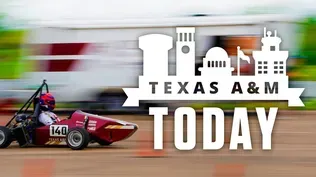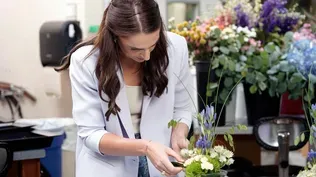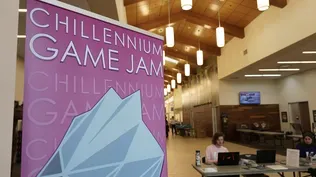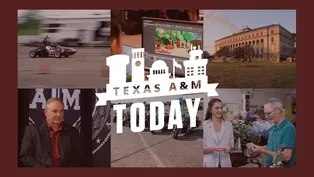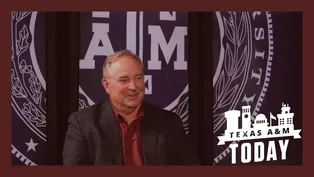
Ep. 5 - Honing Skills at Texas A&M
Season 2 Episode 5 | 29m 8sVideo has Closed Captions
Learn how Aggies and professionals work to hone new skills at Texas A&M.
In Episode 5, check out Texas A&M’s student-led Automotive Engineering team. Watch how the university hosts the nation’s largest annual video game design competition. Learn about the state’s premier law enforcement training from TEEX and see how students design floral arrangements found across campus. Plus, watch a Q&A with Texas A&M Interim President, General (Ret.) Mark A. Welsh.
Problems with Closed Captions? Closed Captioning Feedback
Problems with Closed Captions? Closed Captioning Feedback
Texas A&M Today is a local public television program presented by KAMU

Ep. 5 - Honing Skills at Texas A&M
Season 2 Episode 5 | 29m 8sVideo has Closed Captions
In Episode 5, check out Texas A&M’s student-led Automotive Engineering team. Watch how the university hosts the nation’s largest annual video game design competition. Learn about the state’s premier law enforcement training from TEEX and see how students design floral arrangements found across campus. Plus, watch a Q&A with Texas A&M Interim President, General (Ret.) Mark A. Welsh.
Problems with Closed Captions? Closed Captioning Feedback
How to Watch Texas A&M Today
Texas A&M Today is available to stream on pbs.org and the free PBS App, available on iPhone, Apple TV, Android TV, Android smartphones, Amazon Fire TV, Amazon Fire Tablet, Roku, Samsung Smart TV, and Vizio.
Providing Support for PBS.org
Learn Moreabout PBS online sponsorshipThe Texas A&M Today Show is made possible thanks to Grow College Station.
- Howdy from Texas A&M.
We're on a mission to find the best and brightest at Texas A&M, taking you behind the scenes of one of the nation's largest universities.
In today's episode, we see how students and professionals learn and hone new skills at A&M.
- [Joseph] Out of 70,000 something students, like I'm representing this school with our racing team, and I think that's really, really cool.
- [John] We make a difference every day somewhere.
We don't always find out about it, but we are grateful when we do.
- [Chillennium Participant] The feeling of seeing my art in a video game is just something that's like magical almost.
- Welcome to campus.
Welcome to "Texas A&M Today."
Howdy.
I'm your host, Chelsea Reber, at the beautiful Jack K. Williams Administration Building on the campus of Texas A&M University.
There's an eight-time national championship team on campus, but it might not be a team you're thinking of.
It's Formula SAE, a team that competes with small formula-style race cars.
From the workshop to the track, this entirely student-led organization showed us the ropes of building a car from the ground up.
(soft music) - We're hitting just about 80 miles an hour in this car.
We could probably reach 100.
It's built for going real fast on a cone track.
These tracks are way different from normal race-car tracks.
They're much tighter, they're way harder to drive.
You really have to train yourself to think faster and to move faster.
Have about seven years of carting experience.
Now I'm a driver for SAE.
- The Society of Automotive Engineers is an international organization.
They play a huge role in a lot of industry standards, and because they're so involved with a lot of the big companies, there is an effort made to create these collegiate competition series for the purpose of developing students who are ready to go into industry and take on the hard jobs that need to be done.
Here at Texas A&M, we pride ourselves on starting from scratch each year.
So we basically just start the year with a clean slate.
We don't look at old cars, old models.
And what this means is that every engineer gets to see the entire design cycle, all the way from your blank slate to your initial requirements, to your first sketches, your first models, to your 47th iteration, to your finished product that you've installed on the car.
The way we do it at A&M, it's a little bit more challenging, but it really produces, I think, the best experience possible at the collegiate level.
- To me, SAE, how I've seen it, is mainly a car-building program.
But the more time I've spent through the program and connected with other people and alumni, I've seen it's more of just a teaching program.
I had no prior car experience.
I never worked on my car before joining SAE.
So it was really just an opportunity for me to become a better engineer and to see engineering applications live and be able to put something from the classroom into real life.
- We're looking at all of these different components of different vehicles, and we sit down and we do a lot of research, trying to understand the fundamentals of what it means to do automotive engineering, what it means to build a race car, and how each of these sub-components work.
We start with all of our design, heavy in design, and then we finish our design in the late fall semester.
- The formula internal combustion team actually starts in August.
So we're selected in May by a previous cohort, and we're strictly senior capstone, so it's a whole new class each year.
In those first couple of weeks, we're designing and deciding our need statement and where we want to take our car, what parameters we're going to design around.
I remember after our first design review, we spent three weeks just in the computer labs from any free chance that we got trying to CAD our entire car, and that's pretty much when 90% of it came to fruition was those three weeks before our second design review.
The ultimate goal is, by spring break, we have our car ready to be tested and working out different kinks that we can't foresee as engineers.
- Our testing process.
First, we do driver selection.
So A&M has a very heavy recruitment process for drivers.
The drivers that are selected, we do testing time on our actual vehicles.
So for every year when we finish designing a car, we'll go out to RELLIS or some other place in College Station that we have relationship with, and we'll set up mock tracks, where we'll set up these cone tracks where we'll be able to do some endurance runs.
One of the things that is super critical in getting success in our project teams is being able to give drivers the ability to drive these cars.
And that success, we found, is fundamentally important because drivers being able to be comfortable and being able to know the car and understand the car and being able to drive the car as an extension of themselves, it has made the difference in first place and last place when it comes down to the actual racing.
- One of the big things that we want to do is make sure that we're meeting our driver's needs because not all drivers are running the same race, so being able to push the car is extremely important.
Also, just being familiar with the different aspects of the car.
And a lot of students that race for us, they come from a racing background, so they're used to that competition nature.
They enjoy racing.
- When we first get the car together, it usually doesn't run very well, but you can see the progress.
As we run it more and more, gets faster, it gets more reliable.
I'm looking how the car is balanced, oversteer versus understeer, entry to corner, exit corner, how the powertrain's working.
Are there any issues with the engine?
Is it overheating?
Is it low on fuel?
Is the tune good?
I'm basically just looking over every aspect of the car and trying to relay that back to the engineers so they can make the proper changes.
- The FSAE competition is broken up into two parts.
First is the static events, which is about 30, roughly 30% of the competition, and that tests us as engineers and also a little bit on the business side.
What people are usually familiar with is the racing, and it breaks down into the four events.
We have two drivers that are running acceleration and skid pad, and then the other one is endurance and autocross.
And those are totally different races.
Acceleration, straight line, skid pad is a figure eight, and then endurance and autocross are more tight cornering.
- All of our students are very passionate about automotive engineering, about designing and products and all of these kinds of things that we do because I think fundamentally they understand that this is a very complex project and it's very difficult to be able to do effectively.
And so it gives each of our students a certain amount of pride to be able to produce the level of vehicles that we produce to be able to learn all of the things, to develop their skills, and develop their abilities as engineers.
- The interesting part about A&M is that we get a lot of people from different backgrounds, so we get students that have worked on the farm since they were kids and people that are race enthusiasts, people that just love cars.
And then people like me that we're just passionate engineers that are looking for a good project.
And so because you have all these unique people from different backgrounds, you just have so many thoughts and opinions that can come to the table, especially when you're designing or making really big decisions.
And I think the best part about this experience was just being able to learn from other people and how they think or how they approach a problem.
- And this is just a very rewarding experience to be part of a team that cares so much about what they do.
Your teammates are always gonna be motivated and driven.
These organizations can be a little bit exclusive, so that means that everyone you're working with is well qualified, and they really want to be there.
And that means they're putting in the time, they're working to solve any problems that come up.
There's nowhere else that you can get this sort of hands-on experience at the collegiate level.
A lot of people won't get to mess with this kind of technical work until they're multiple years into industry.
- The organization is expanding to a fifth discipline.
After a 19-year absence, a solar car racing team is returning to campus.
They plan to begin competing in 2024.
What do Americans spend billions of dollars on that always get a smile?
Flowers.
Floral designers can turn a few cut flowers into breathtaking arrangements.
But to be able to make those beautiful designs, someone has to train them.
(light upbeat music) Wedding bouquets, event centerpieces, and Valentine's Day arrangements don't just happen on their own.
It takes a trained eye to mesh colors, styles, and methods into cohesive, stunning designs.
That's where Bill McKinley comes in.
He's Texas A&M's resident floral expert, and today he's going to teach me.
- You have to know in the ins and outs of art, elements, principles of design, but you also need to know how those things go together and how plants grow in order to make an aesthetically-appealing design.
- [Chelsea] Bringing years of experience to the job, McKinley teaches students during the school year and trains professionals during the summer.
His small classes are immensely popular and hard to get into.
- Probably only about four or five other universities have floral design.
We get participants from all over the country, all over the world.
We have someone from Taiwan, we have someone from Hong Kong and Korea, just recently.
- If you've been to a university event, you've seen his work.
He designs arrangements for dozens of events each year, for clients like the president, the chancellor, athletics, and more.
I was surrounded by flowers and had one request.
I would love to make an arrangement today, if you are willing to teach me.
- I would be honored to do so.
So we have lots of choices to make.
- [Chelsea] As we gathered our materials, McKinley told me he's part of a worldwide industry worth $33 billion that allows him to procure flowers from all over the globe.
We picked out beautiful carnations, astrantias, and more.
Then it was time to get to work.
- So what we're going to do is make a Kubari mechanic first.
- [Chelsea] We started with wood skewers and aspidistra leaves.
- Fold it two to three inches.
And then backwards.
You're just gonna skewer it so it comes straight through.
- [Chelsea] We repeated that process with three more leaves, then began building our base.
- I'm gonna group them together.
So that they kind of have a stronger presence.
Now the carnations.
This is a nice color contrast.
- [Chelsea] Then we focused on building height.
- Now we're just gonna kind a stair-step up, each one a little bit taller than the previous.
- [Chelsea] We finished with some tall greenery for balance.
- Could be one stem or if you need two for extra balance, you can certainly use two.
- [Chelsea] Before I received my grade.
- Looking good.
- Pretty.
- You have created a very nice Kubari design.
- [Chelsea] Well, thank you.
Of course, as McKinley told me, everyone likes different designs, but there are standards he's able to teach his students, and those moments are his favorite part of the job.
- It's seeing those little lights come on in students' heads when, "Oh, that's how that happens," or, "I didn't know it was so complex "to make a floral design."
- Then it was time for my visit to end, but my designing days might not be over.
Thank you so much for teaching me today.
- You're welcome.
- Yeah, this was fun.
Brought back some memories.
- Oh good, good, good.
So I'm expecting you to go home and make some of these.
- Okay, I'll send you pictures.
- Good deal.
(soft music) - The design Bill McKinley walked me through was beautiful, and the process was a lot of fun.
We've put the full video of his demonstration on our YouTube channel as an exclusive digital bonus.
How long would it take you to make a video game?
Could you do it in 48 hours?
I couldn't, but some of our talented visualization students can.
Every year they invite other schools to campus to compete in the nation's largest collegiate game jam.
It's about having fun, building confidence, and networking with the pros.
(light upbeat music) - For my game plan this year, I plan to put in my work during the day, get my work done, but the moment I start seeing progress slow and that the screen starts to hurt the head, I'm going to sleep.
It might be an hour, two hours, three hours, depends on how much stuff we have done or have to do, but I'm not cutting my sleep because that is going to help me continue to get things done well.
Not just get them done, but get them done well.
- I haven't had a whole lot of experience making video games, and so the idea of making one in one weekend was kind of crazy to me, so I wanted to see what that was like.
(ethereal electronic music) - What sets Chillennium apart from other game jams?
Well, number one, it's the largest collegiate in-person game jam in the world.
Several years ago, we actually got the world record with 309 participants.
What is a game jam?
It's a group of people getting together and making a game in a specified amount of time, given a prompt.
So in the case of Chillennium, it's 48 hours.
The participants, our students, college students, are being given a prompt this evening, and then they have 48 hours to make a game.
(upbeat music) (audience cheers) - [Audience] Five, four, three, two, one.
(audience cheers and applauds) - Yeah, at first I'll admit I was a little scared, a little daunted.
When they announced the theme, it was a big rush to get an idea as fast as you could in order to start because, again, we didn't have much time.
But it was also important to sit for a little bit and think, "Is this really the best idea that we have?
"What else can we think of?"
- This Chillennium, we're expecting 234 participants from 24 different schools.
We have many industry mentors here from major gaming company.
I believe over 40 mentors this year from EA, from Bungie, from ProbablyMonsters, from Epic, from BioWare, Bluepoint, SideFX, and so on.
Just to name a few.
- Texas A&M has really prided themselves in this event, and I know that the things that we do at A&M, we always go big.
We always go bold.
And so it's been no surprise to me that over the years that this event has gained so much momentum.
When I was at Texas A&M doing visualization, we didn't have a whole lot of games-related curriculum.
And so now that it's kind of exploded, it's been amazing to see just the momentum that has come behind game development and creation here at the university.
And I definitely wanna be a part of continuing to support that.
I'm so excited to see where gaming has gone within the visualization program, and I continue to intend to be an active part of it and support it as much as I can.
And Gig 'em to the visualization program for believing so much in games and for driving the future of this industry.
(upbeat electronic music) - I think the main takeaway that I got was to learn to take a step out of your comfort zone.
Try something you wouldn't necessarily do ordinarily, and just see how it goes and what you like.
But now that it's all said and done, it really is an accomplishment.
I feel really good about myself, my ability, now that I've proven to myself that I can do it.
- When I was on my way here, the only thing I wanted was a team that I knew could do the jobs that they were assigned, and this team did exactly that plus more.
Our programmers were excited to stay back and like figure things out and find new ways to implement.
Like we got excited about our concept, and we were on a like a similar wavelength.
And it was really cool because I didn't expect to have that kind of connection with a team at Game Jam this year.
Like I just expected it to be like, "Okay, I'm kind of the outsider," but they really brought me in, and we all thought in one mind and put a great product out there.
We've pushed the bounds of what I thought we could do by miles.
Like this is a game that I'm extremely excited to just put on my portfolio and tell people and show people about like, "I made that."
I put my effort into this and be proud of it.
It's genuinely something I could see like on a site, people paying for.
I think it's a great product we made.
We pushed every expectation I had.
(upbeat electronic music) I feel so proud.
I get goosebumps whenever I think about it.
I can't wait to show this game to my friends and my family.
I am exceedingly proud of my team, of myself, and of the work we made.
(upbeat electronic music) - Most of the games are available for download, and a few can played in a web browser.
Head to the show page on our website for a link if you'd like to check out the games for yourself.
Now it's time for an Aggie Fact, and it's about the building I'm in today.
Plenty of graduation and wedding photos are taken in front of the beautiful Jack K. Williams Administration Building, but the inside might be even more picturesque.
Built in 1932, the decorations are rich and high-quality, and it could take hours to see all the details.
There's stained glass, murals, and a map of Texas.
Bronze marble and gold leaf are everywhere.
Former architecture department head, Ernest Langford, once called the building, "The most grandiosely conceived structure "ever built on campus."
Two people have laid in state in the great hall, renowned university president, General James Earl Rudder in 1970, and Eli Whiteley in 1986, one of eight Aggie Medal of Honor recipients and a long time A&M professor.
Law enforcement provides many invaluable services to the state, but they wouldn't be able to provide some of those services without important training through the TEEX law enforcement division.
From emergency communications and explosive ordnance disposal to motorcycle driving and drone training, it all starts here.
(chill music) - Anything that a community needs to survive on a daily basis and particularly during an emergency, TEEX provides it, including emergency management training.
I'm the Division Director here for the Institute for Law Enforcement and Protective Services Excellence, a division of TEEX.
Our organization was established to provide law enforcement extension training.
We are the organization, as a state agency, that is responsible from one end of the state to the other to provide training to particularly rural and under-resourced parts of Texas to go and deliver those trainings where officers and agencies find it difficult to get high-quality law enforcement training.
Just about anything that you can think of that is in the protective services or security field.
So in addition to very basic law enforcement training, we have this layered advanced training for things like our bomb disposal, or, rather, our UXO program.
We also have a humanitarian demining program.
We just recently had some individuals that have been serving in Ukraine come and get their certification so they can go back and keep rendering those humanitarian services, this time in the form of ordnance disposal.
And we're real proud to be part of those efforts.
- Because it is a powder train time fuse.
If you look right here.
See the C?
- Yeah.
(chill guitar music) - The instructor cadre we have here is the best in the world.
They come from all levels of government, from the federal government.
I've got several FBI, former retired FBI instructors.
The United States Marshals, the ATF.
At the state level, we've got DPS troopers, police chiefs, assistant chiefs, detectives, forensic science experts.
I'm the Training Coordinator for the National Police Motorcycle School here at TEEX.
Right now, we're in the middle of a basic police motorcycle school.
It's a two-week-long school, so the basic riders are on their fourth day, and they're being trained by instructor candidates that we trained last week for methods and instruction, adult learning principles, coaching positions and all that.
And then those training instructors teach a basic operator school.
- My name is Aaron Baldwin.
I'm a Sergeant with the Harris County Sheriff's Office, Vehicular Crimes Division, and I'm currently assigned over the traffic enforcement, which is all the motorcycle units in Harris County.
Last week, I came and started my instructor course.
So I'm currently going through the motorcycle instructor school here, which has been very eye-opening for me as well.
- Harley gives us all the technical support, all the motorcycles, this training rig that we have here.
We have everything we need to do to put a school on the road.
So far this year we've been to Mississippi, New Hampshire, New Jersey, back here, and then later on we're gonna be in the Dallas-Fort Worth area.
- I am Bryan Yeatman.
I'm a Corporal with the Chambers County Sheriff's Office.
Just looking into starting a a motor unit at our agency.
They sent me and another officer here to get basically certified.
I hope it brings a lot.
I assume we would mostly be traffic enforcement, help slow people down, obey the traffic laws.
We have quite a few schools in our county that we have to patrol for the school zone.
- I think the training that we have learned here, there's a safety aspect that we have learned that I would like to take back to make sure that it is a firm grasp for the other riders at the department.
At the end of the day, that's the most important thing.
- Pull back or push 'em forward.
Go get up there close, Judge.
- You have to have safe officers out here riding around the street.
'Cause we don't want them to get hurt, we don't want them to hurt somebody else.
- The public expects a police force that enforces its laws, keeps it safe, but does it while preserving the dignity and respect of the community it serves.
The mission of the Law Enforcement Training Division here within TEEX is just one piece of a larger puzzle.
That's what we strive to do around here, making policing better, and I'm committed to doing that, as is the staff here, as long as we're here.
- TEEX doesn't just train law enforcement.
Their other divisions train electric linemen, firefighters, cybersecurity groups, and more.
Next, I caught up with a Texas A&M difference maker for a one-on-one conversation.
Today, that's Texas A&M University Interim President, Mark Welsh.
After 40 years of service in the U.S. Air Force, General Welsh retired in 2016 and was later named Dean of the Bush School of Government & Public Service.
He then took on the role of Interim President in July of 2023.
You did not go to school here.
- We were an Aggie family, and the indoctrination started really young at my house.
My dad credited his time at A&M for everything good in his life.
- Your speech at Muster in 2022 made an impact on several people.
Tell me about the process of writing that speech and why that message was so important to you.
- As I started preparing for it, I think the biggest thing was I felt my father there.
Which really sounds corny, unless you're an Aggie.
You kind of get it.
And I miss my dad.
I really miss my dad.
So having him with me through that process was a big deal.
I've spoken in a lot of places, but I've never had that feeling before.
- You have served all over the world, yet you ended up here at Texas A&M University.
What initially brought you to College Station, and what has kept you here?
- My admiration for George H.W.
Bush and my love of Texas A&M.
I literally have always loved the place, I mean, since I was six.
And so those two things came together with an opportunity that a friend here at A&M contacted me about and said, "Would you be interested in competing "to be the Dean of the Bush School?"
- What is your leadership philosophy?
- I believe that everyone, everyone here, every faculty member, every staff member, every student is critically important to what we're trying to do at Texas A&M and to the success of this institution.
And they deserve to be treated that way.
- What excites you about the future of Texas A&M?
- Oh, everything.
I mean, just everything.
We have this incredible world-class faculty and staff.
We have the greatest students on the planet.
We have unbelievable support from everybody, from our chancellor, to the Board of Regents, to leaders of the state of Texas.
In fact, that support's the envy of our peers everywhere.
And all of it's connected to this legacy that is equal to the legacy of any institution in the country.
Aggie are already changing the world.
They're gonna keep changing it, and they're gonna matter wherever they are, whatever they're doing, and here we get to help 'em get ready.
It's just an exciting place to be.
- President Welsh, I know you're a busy man.
Thank you so much for making the time today.
- Oh, I'm honored to be here, thanks.
- You can watch the full version of our conversation on our website.
That's it for this episode of "Texas A&M Today."
You can watch all past episodes on pbs.org, or our YouTube channel.
Gig 'em!
(upbeat music) (upbeat music) (upbeat music) (upbeat music) The Texas A&M Today Show is made possible thanks to Grow College Station.
Video has Closed Captions
Preview of how Aggies and professionals work to hone new skills at Texas A&M. (30s)
Extended Cut: Interim President Welsh Q&A
Video has Closed Captions
Watch Chelsea Reber’s interview with Texas A&M Interim President, Gen. Mark Welsh III. (18m 8s)
Providing Support for PBS.org
Learn Moreabout PBS online sponsorshipSupport for PBS provided by:
Texas A&M Today is a local public television program presented by KAMU
